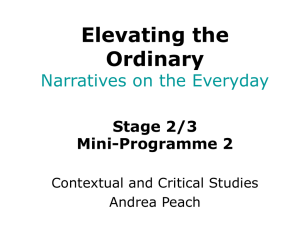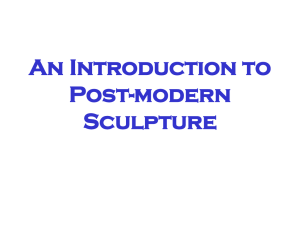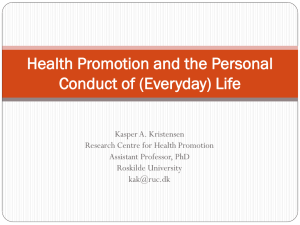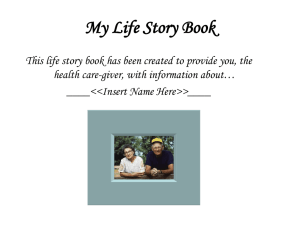PPT
advertisement
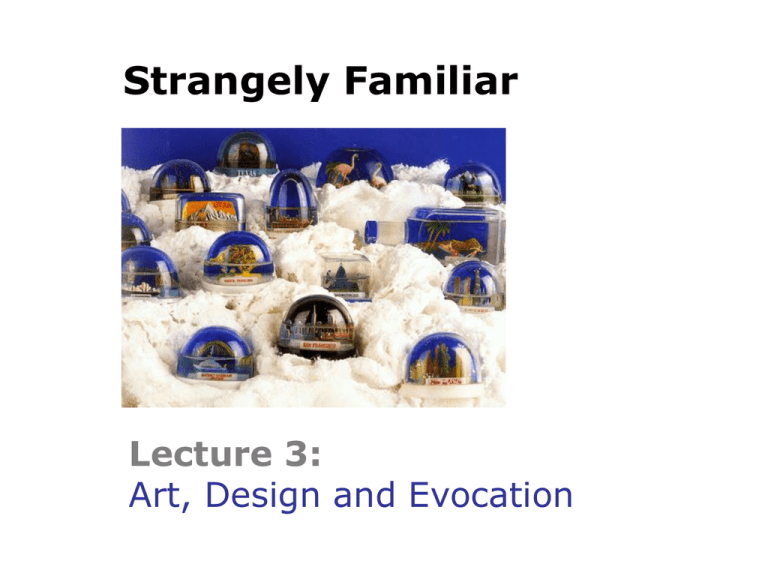
Strangely Familiar Lecture 3: Art, Design and Evocation Memory Making Memory and Material Culture “Memory” is commonly envisaged as both the facility to remember and as the mental representation of that which is remembered. Memory Making Memory and Material Culture In contemporary Western societies, ‘memories’ are often conceived as possessions: we ‘keep’ and ‘preserve’ our memories almost as though they are objects in a personal museum Karsten Bott Personal Museums One of Each on Shelves 2000 Sophie Calle Personal Museums La Visit Guidee (the bucket 1994) Olivier Peyricot Personal Museums Object Holder Curtain 1995 Material Memories The Physical Past Objects serve memory in 3 ways: They furnish recollection; constitute a picture of the past They stimulate remembering They form records, storing information beyond individual experience Marcel Proust (1871-1922) A La Recherche du Temps Perdu The past is hidden somewhere outside the realm, beyond the reach of intellect, in some material object (in the sensation which that material object will give us) of which we have no inkling. And it depends on chance whether or not we come upon this object before we ourselves must die. Photographs as Objects of Memory Photographs belong to that class of objects formed specifically to remember, rather than being objects around which remembrance accrues through contextual association Photographs as Objects of Memory Anya Gallaccio Photographs express a desire for memory and the act of keeping a photograph is, like other souvenirs, an act of faith in the future. They are made to hold the fleeting, Broken English August ‘91, 1997 to still time, to create memory Clothing as Objects of Memory Juliet Ash Clothes relate to our feeling more than perhaps any other designed artifacts, and thus require ‘subjective’ as well as ‘objective’ analysis … clothes, their smell and texture, remind the spectator of past presence of the person to whom they belonged, their inhabiting them, a moment when they wore them. The garment becomes imbued with the essence of the person. Clothing as Objects of Memory Christian Boltanski (1944-) What they have in common is that they are simultaneously presence and absence. They are both an object and a souvenir [or memory] of a subject Canada, 1988 Clothing as Objects of Memory Martin Margiela Museum Boijmans van Beuningen Rotterdam, 1997 Clothing as Objects of Memory Tejo Remy Products acquire meaning with the passing of time, through use. However developments proceed so rapidly that many objects for use have no chance to acquire real meaning. Products should really be granted a longer useful life. Rag Chair, 1991 Collection Droog Design Gijs Bakker Strangely Familiar Wallpaper Peepshow 1992 Jurgen Bey Strangely Familiar Kokon Series 1997-99 Jurgen Bey Broken Family Service 1999 Rachel Whiteread (1963-) Strangely Familiar I always use second-hand things because there is a history to them …I once got a load of second-hand bedding from the Salvation Army and it was sweat and urine stained. All things I was trying to use … The smell of people, just everyday living … Rachel Whiteread (1963-) Closet, 1988 I was trying to make a space that I was very familiar with and that a lot of people would be familiar with. And I have a very clear image of, as a child, sitting at the bottom of of my parents’ wardrobe, hiding among the shoes and clothes, and the smell and the blackness and the little chinks of light, and I was really trying to illustrate that … I was trying to make that space solid. Rachel Whiteread Paul Hessels Droog Design Detail from Untitled (Upstairs) 2001 Power tiles 1995 Tejo Remy You Can’t Lay Down Your Memories 1991 Ben Highmore Figuring the Everyday To launch an investigation into the theoretical practices of those who attend to everyday life requires attention to everyday life itself. David Shrigley Imagine the Green is Red, 1997 Marcel Duchamp The Ready-made (1887-1968) I cast the urinal before them as a challenge and now they admire it because of its aesthetic beauty. Marcel Duchamp Marcel Duchamp The Ready-made (1887-1968) At last that ‘wretched urinal’ existed in ‘real’ art materials … ! Sherrie Levine - Fountain 1991 Henri Lefebvre (1901-1991) Why should the study of the banal itself be banal? … Why wouldn’t the concept of everydayness reveal the extraordinary in the ordinary? Stage 2 Seminar Tomorrow: Task: Many writers, most notably Marcel Proust, have written about the ways in which time and memory are encoded in our perception of everyday things. Come to the seminar with an example of work from a contemporary artist or designer, which explores the idea of memory and ‘the familiar’ using everyday objects. Stage 3 Workshop Thursday: Task: Reflect on the 3 lecture themes and weekly readings. Come to the workshop prepared to discuss your ideas for your essay. What sort of ‘question’ might you ask of The Everyday …
